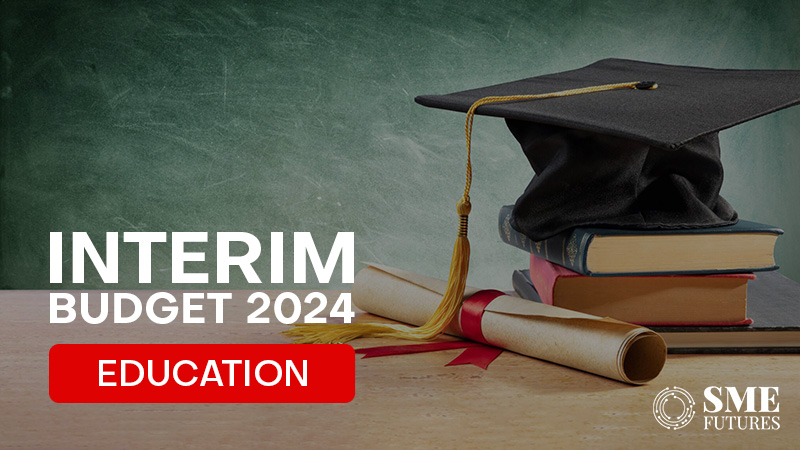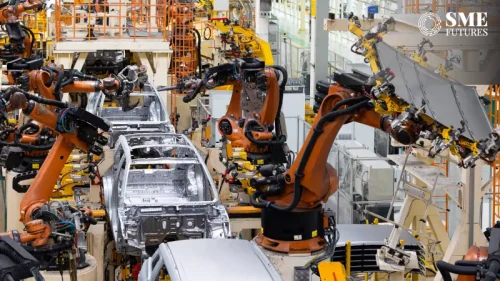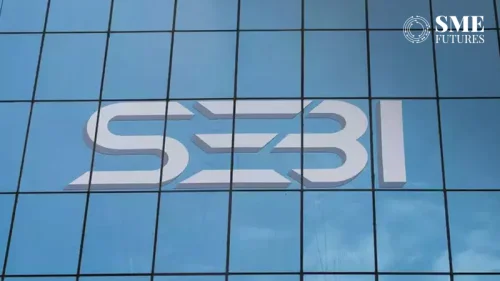The Ministry of Education got Rs 1.20 lakh crores in the Interim Budget 2024-25, indicating an overall decrease of 7 per cent compared to the revised estimate number for 2023-24.
Here are the key points related to education outlined in the interim budget, providing insights into the government’s strategic focus on fostering a robust educational ecosystem.
Despite a fall in the overall funds, this year, the government has allocated the highest-ever funding to the Department of School Education and Literacy, Rs 73,008 crores. This is 0.7 per cent higher than the revised estimate of 2023-24.
Further, higher education has received Rs 47,619 crores in 2024-25, a decline of 18 per cent from Rs 57,244 crores (revised estimates) in 2023-24.
The budget for PM SHRI, a Ministry of Education (MoE) scheme which seeks to upgrade existing government schools to model schools, has risen from Rs 2,800 crores in 2023-24 (RE) to Rs 6,050 crores in 2024-25–an increase of Rs 3,250 crores.
Poshak Agrawal, Co-Founder of Athena Education says that this interim budget delineates a strategic roadmap for India’s progress, leveraging new-age technologies and data to drive economic opportunities.
“This budget represents our nation’s resolve to harness innovation and entrepreneurship in our pursuit of a better world. As India positions itself on the global stage, the emphasis on technology transforms lives and ensures economic inclusivity, particularly for the underserved,” he says.
Let’s see how these funds will be spent for the development of education in India.
Fiscal allocations for education
The revised and projected estimates in the interim budget reveal a strong financial commitment to education. The focus on increased revenue receipts and sustained growth momentum indicates a conducive environment for channelling resources into education. Additionally, the continuation of schemes for interest-free loans for capital expenditure to states reflects the prioritisation of educational infrastructure development.
Manisha Zaveri, Joint Managing Director, Career Mosaic, says, “The introduction of a substantial fund for interest-free loans to support private-sector research and innovation is a positive development. This budget is foundational for empowering India’s youth in shaping the country’s technological advancements and international stature.”
Make students resources
The budget emphasises the critical importance of investing in human capital and education stands at the forefront of this endeavour. The government’s approach to bolstering educational infrastructure, quality, and accessibility reflects its vision for a developed India.
The focus on education to enhance human capital underscores the government’s commitment to long-term sustainable growth through a well-educated and skilled workforce.
According to Sarvesh Agrawal, Founder and CEO, Internshala, this interim budget is the cue to enhance skill development programmes in areas like deep tech, generative AI, and green technologies such as electric vehicles and solar power.
Dr. Silpi Sahoo, Chairperson, SAI International Education Group, highlights the importance of sports in the all-round development of an individual and observes, “Empowering our youth is a critical success factor towards our nation’s prosperity. The government’s strong focus on sports has already generated a new civilisational confidence in our sportspersons. Our highest-ever medal tally in the Asian Games and Asian Para Games in 2023 stands testimony to that.”
Focus on skilling
The interim budget underscores the importance of skilling and fostering a well-trained workforce. The government has a clear emphasis on not just formal education but also on skill development to align the workforce with the demands of a rapidly evolving economy. This aims to bridge the gap between education and employability.
Prof Arvind Sahay, Director at MDI Gurgaon remarks, “The impressive accomplishments of the Skill India Mission which has trained 1.4 crore youth and upskilled 54 lakh individuals, play a crucial role in bridging skill gaps and fostering growth. Additionally, the enrolment of 43 per cent of females in STEM courses reflects our progress in promoting gender inclusivity. These initiatives promise a brighter future for India’s youth and signify a positive trajectory for our nation’s development.”
Sachin Jain, Country Manager, ETS India and South Asia, emphasising on the importance of research, says, “The budget prioritises the upskilling of the youth and endorses the spirit of ‘Jai Anusandhaan,’ envisioning a future where Indian youth lead in innovation and research.”
Commitment to addressing societal changes
Lately India is witnessing a surge in female literacy, however we have a long way to go. In response to the challenges arising from rapid population growth and demographic changes, the government introduced the formation of a high-powered committee dedicated to considering these issues comprehensively.
This initiative showcases an understanding of the societal impact on education and the necessity to address these challenges proactively, aligning educational strategies with demographic shifts for the betterment of Viksit Bharat.
Charu Malhotra, Co-Founder & MD, Primus Partners, asserts that furthering the NEPs vision, the budget put out the need for increased female enrolment by 28 per cent in ten years, which will give more agency to women in the coming decades.
“Such a vision mandates the inclusion of 6 million females in higher education and creates a seriously huge obligation for all those who count themselves as part of the nation-building ecosystem,” she says.
She further adds, “The first in this ecosystem who become responsible for the success of this vision are the higher education institutions. They have a responsibility to collectively create infrastructural and institutional capacity in their institutions, especially hostel accommodation for girls from underserved areas.”
The second critical player is Corporate India which under its CSR initiatives, can collaborate with the government by supporting the progression of girls into higher education through financial assistance in the form of scholarships, especially in STEM.

Educational reforms and development
Addressing the need for growth and development-enabling reforms in the states, the interim budget highlights the provision of significant interest-free loans to support milestone-linked reforms by state governments.
Dr. Yajulu Medury, Vice Chancellor, Mahindra University, says, “The Budget 2024 exemplifies the government’s commitment to empowering ‘Amrit Peedhi’, our youth and the NEP 2020 reaffirms its commitment towards transformative reforms, ensuring quality education and inclusive development.”
Expectations from budget
Since it was only an interim budget and the full budget is supposed to follow the parliamentary elections in India, some industry leaders have raised concerns about the interim budget while simultaneously raising demands for the final budget this year.
For instance, stakeholders were expecting some relief in tax structures.
Prof Arvind Sahay, Director at MDI Gurgaon, says, “The first downside in the interim budget is that there is a missed opportunity to rationalise taxes. Indian rates are already high comparatively. The aim must be to make India the place to invest in because it is a great tax destination. The fiscal headroom allows this. The second miss is a lack of sufficient increase in investment in R&D. A developed nation requires the central government to lead from the front in R&D.”
While PM Schools for Rising India (PM SHRI) play a pivotal role in delivering quality education and fostering holistic development, Beas Dev Ralhan, CEO, Next Education, points out that there is an urgent need to realign the education system with market demands, ensuring that the youth not only receive theoretical knowledge but also acquire practical skills.
“This strategic focus is essential to empower the younger generation to contribute meaningfully to the progress of our nation,” he says.
Need for education infra
Another area that concerns stakeholders is improving the infrastructure for education.
Gautam Rajgarhia, Pro Vice Chairman, Delhi Public School, feels that a more substantial allocation towards improving educational infrastructure, providing digital equipment, and enhancing resources for students nationwide should have been provided.
“The creation of dedicated teacher training centres would significantly amplify the impact of educational initiatives. Relying solely on the Public-Private Partnership (PPP) model and traditional B.Ed colleges may prove insufficient in effectively empowering teachers. Therefore, a strategic allocation of additional resources towards comprehensive teacher training becomes imperative,” he highlights.
Nischal Narayanam, Head of Nischal’s Smart Learning Solutions, asserts, “By investing in RIE-like institutions and empowering our teachers, we can create a strong schooling system that fosters innovation and critical thinking and prepares our youth for future challenges. We remain hopeful that our government will prioritize this in the future and allocate funds to broaden robust training modules aligned with industry demands and emerging technologies,”
More tech power
Piyush Kulshreshtha, Founder & CEO, Khul Ke, pointing out the need for increased tech interventions, says, “We had requested a separate budget for the adoption of world-class technologies developed by Indians under Atmanirbhar Bharat and Start-Up India under the Digital India initiative. The government must adopt a transparent and fair policy in all areas while emphasising sectors where India has historically lagged and give them a special advantage.”
Ashish Tibdewal, Country Director-India, Global Schools Foundation, contends, “To truly propel our education system forward, we must prioritise the integration of AI in hybrid education and learning methods. This will not only enhance personalised learning experiences but also equip students with essential future-ready skills.”
Overall, the government’s emphasis on human capital investment, educational reforms, addressing societal changes, and robust fiscal allocations reflects a holistic approach towards nurturing a well-educated, skilled, and adaptable population. The strategic focus on education in the context of Viksit Bharat outlines a promising path for transforming the educational landscape and shaping a brighter future for the nation.











